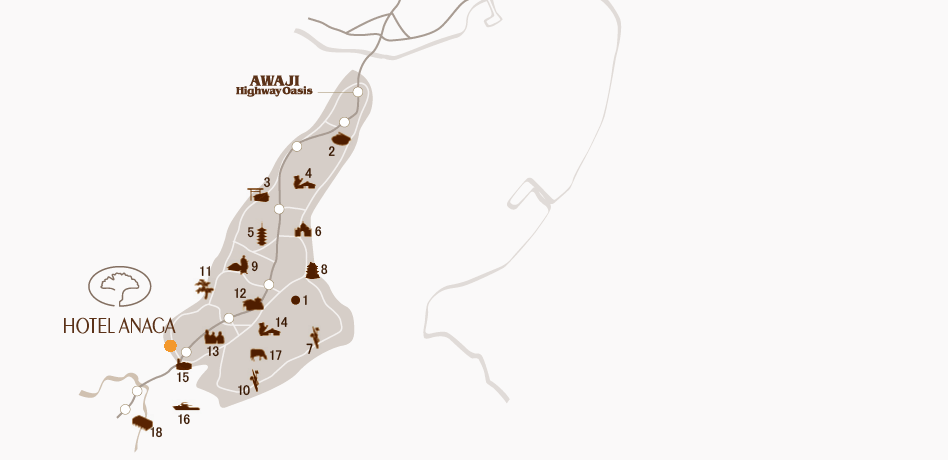
With a Water Temple designed by the world-renowned architect, Ando Tadao, the light from the evening sun shining down into the inner sanctum is truly beautiful. Constructed at the end of the Heian Period (794 – 1185), this temple has a principal statue of Yakushi Nyorai designated an important cultural asset by Awaji city (formerly Higashi-ura-cho).
Named after the renowned mythical deities Izanagi and Izanami, responsible for the creation of Japan, the Izanagi Shrine was formerly a top ranked Imperial Shrine. There is the 800 to 900 year old Great Husband and Wife Camphor Tree, a designated Natural Monument, as well as a monument to Sandalwood, the source of Awaji Island’s famous incense tradition.
As head temple of the Shichifuku, 7 Lucky Deities, the Hachijo Temple has a 2m statue of Daikoku-sama, the God of Wealth, enshrined as its principal Buddha. With a sack in his left hand containing the hardships he has removed, in his right hand he holds a small mallet with which he dispenses good fortune.
A temple at the center of Awaji’s mountain worship with a distinguished history, it is located on the top of Mt. Sen, known as the Awaji-Fuji and said to be the very first mountain brought into existence by the mythical gods Izanagi and Izanami when they created Japan. The triple pagoda on the summit is believed to have been repaired by the famous Awaji merchant, Takadaya Kahei.
Featuring a miniature world featuring famous world landmarks scaled to 1/25th of actual size, a ‘Ruins of the World’ display of such ancient civilizations as Egypt, Mexico and Colombia, as well as a magical Fable Forest for children to explore famous stories and fables of the world.
One of Awaji’s two daffodil parks, and one of the 3 largest colonies of flowers in Japan, this park features over half a million wild daffodils. In contrast to the Nada-Kuroishi Fields which are predominantly Japanese daffodils, this tourist garden is cultivating many varieties of Mediterranean flowers.
Built in 1526 on Mt Mikuma overlooking Sumoto City, this castle was once a stronghold for the Kii Kumano domain of Wakayama Prefecture, under the control of the Atagi clan of the Kishu-Kumano Navy. Registered as a National ruin, the culture and history features at the Awajishima Museum in Sumoto.
Born in Goshiki-cho, Awaji Island, Takadaya Kahei was a cargo trader operating between Honshu and Hakodate in Hokkaido, as well as Russia. Visit the Memorial Hall to learn about his life through pictures, artefacts such as his telescope, maps and letters, as well as models of his residence and trading ship, the Shinetsu-maru.
Started 180 years ago when a fisherman found a plant bulb washed ashore and planted it on the hillside, the Kuroishi Daffodil Fields in southern Awaji Island now occupy nearly 7 hectares, covering the whole side of Mt Yuzuruha from its 608m peak almost to the sea.
Located in the west of Awaji Island, the Keino Pine Fields are a famous picturesque area mentioned by the renowned waka poet Kakinomoto no Hitomaro, as recorded in the Man’yoshu collection of poetry. Featuring 50,000 black pines growing thickly along a 2.5 km stretch of fine white sand, this is the premier pine field in the whole Seto Inland Sea, popular for its swimming area and fine sunsets.
This art museum houses a superb collection of Modern Nanga art (Southern Chinese style brush painting) by the calligrapher, Zen teacher and premier painter in the Japanese Nanga world, Jikihara Gyokusei. His representative work, the Zen Ox-herding pictures, are featured here among many other famous pieces.
Come and experience the beauty of traditional Japanese puppet theater at the Awaji Doll Joruri Pavilion. With around 500 years of history, Awaji puppet theater, listed as an Important Intangible Folk Cultural Property, is the origin of the renowned Osaka Bunraku and Tokushima Awa-puppet tradition. Six performances every day.
Styled on the Lakes District in England, this enormous farming park is about 14 times the size of Koshien Stadium. Come and meet all kinds of animals, from koalas and wallabies to rabbits, monkeys, colorful parrots and eagles. You can even try your hand at making your own bread and sausages, as well as go strawberry picking.
Located only 10 minutes from Hotel Anaga, the Naruto Bridge Museum is popular for its magnificent panorama of the Naruto Straits and bridge, from the sea and Uzushio whirlpools all the way to the distant mountain ranges of Shikoku. Experience the 3D picture show and see Naruto Bridge and the whirlpools in their entirety.
Come and see the famous Uzushio whirlpools up close with a 30-minute cruise.
The home of Awaji beef, this farm offers the chance to enjoy close interaction with the animals, from milking cows directly to making your own cheese and butter.
This world-first art museum has over 1000 priceless masterpieces, representing the entire history of Western art, preserved and reproduced in their original size on ceramic tiles.



